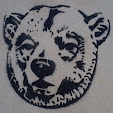I picked up a couple of rather interesting aircraft models a week ago last Saturday, neither of which seem to be elsewhere on the Internet, so we'll look at them both and thoughts are welcome on these two mysteries, the first is a kicker for Brit's . . .
. . . as I suspected first that Victory Toys were likely a US firm, before finding it (as an aluminium Jeep manufacturer) in the archive as being a Dutch/Netherlands maker, but the point is, it's inescapable that this composition B17
Flying Fortress is a world away from the lumpen models we've seen here previously from
Zang for Timpo. I don't know if the dodgy-looking characters (possibly a dog, a human and a duck) have any significance, or are a further clue to anything?
I wondered if at first it was aluminium, Victory seem to have made figures in the same material, as well as the Jeeps (all around 60mm), but it's definitely a composition; you can see where light rust on the prop-shafts is just starting to split the cases on the port-engines. Also, the varnish, where it hasn't worn off, is starting to bubble, like the unit/nationality shield transfers on a WWII German helmet I used to own - clearly reacting with the paint underneath.
Only, it's a very finely finished model, as you can tell from this comparison of another recent airborne discovery here at Small Scale World, the Zang B29 Superfortress, you can see it's a much cruder beast altogether, and you wonder if, at that level of finess, we don't still have composition toys, but that's forgetting the frangibility of the material, and the fact that it's only survived because the box has soldiered-on, getting a bit battered, defending the contents!
Typically, the B17's from Zang which we also only recently looked at, are in storage, but that will give us an excuse to return to the whole Air Wing one day, as there are some lead ones too, and a wax one! Going by the scale on the wing of the next, below, these are about 1:300th scale?
The other 'plane I found that day was this cast-aluminium MR2/Mk.2 Shackleton, long range maritime-patrol/reconnaissance aircraft. The official recognition model was a 1:72 scale celluloid/phenolic model, made by Cruver, and most of the desk-models I could find are far more detailed/larger, so I was minded to suspect an apprentice piece, however, the 52/986 looks like a stock-code, so it may still be a recognition model, or perhaps a targeting-aid, but I'm not sure that I'd be very happy if our gunners were practising on models of our own aircraft?
Now, 52 could be the year, and 986 is close to codes used by Avro for both the Shackleton (696/716) and Lincoln Bomber (694/695), so this could be an Avro factory/design office model? I can see there's still more to learn about this!
The small recess shows no sign of glue or fixings, so seems to be designed to fit easily on a stand of some kind, and be removed again, while the yellow-brown paint is crudely done, compared to the all-over green, but seems to be original?
And here's another thought, the Shackleton has direct descendancy from the Lancaster, via the Lincoln, and I wonder if the fact that around the world, three Lancaster's have now (I believe) been rendered airworthy, is down to the number of Shackleton parts still kicking around here or in South Africa?







No comments:
Post a Comment